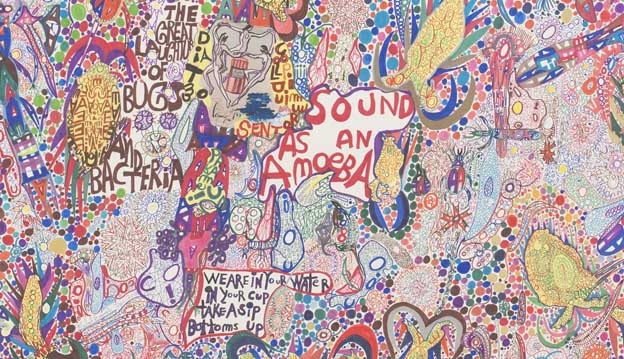
I wished for a form that would invite those passing-by lovers of the poem to read with their imaginations, principally and perhaps only, and further for a form that would accommodate all the various types of poetry possible in the realm of the poem. My offering was an opem, a typo. So, put simply, an opem is an unstable area among a visual poem, an aural sound, oral scape, score, any form of poem in germination or poetry complete, and music, visual art, dance, performance, and I do mean: etc. Uneasy, unfixed, a form of forms, open, with as few limits as can be supposed, and within the opem space, all form, genre, or type respectively coexist in syndicate. It’s all a blur. The opem authority resides with the individual imagination actualizing and engaging the opem. Que será, será.
To begin a recitation, consider the following:
An opem poem reveals multiple entry points. Access begins everywhere and anywhere.
Manifestation demands full, active participation with the opem. Upon first contact, all become active contributors.
Improvisation is reading. The prime improvisation symbol is ![]() . In opem improvisation, be spontaneous, riff, refrain. All solid color circles, black, white, yellow, brown, yellow, etc., are/can be a cue to improvise. As a factual suggestion every mark, symbol, constellation of letters, any letter, and/or prepared image of an opem suggests an improvisation and vocalizing should/could/would will occur. As a participant, vocalize each app, prompt, or utter consideration in accord or discord with the individual imagination.
. In opem improvisation, be spontaneous, riff, refrain. All solid color circles, black, white, yellow, brown, yellow, etc., are/can be a cue to improvise. As a factual suggestion every mark, symbol, constellation of letters, any letter, and/or prepared image of an opem suggests an improvisation and vocalizing should/could/would will occur. As a participant, vocalize each app, prompt, or utter consideration in accord or discord with the individual imagination.
Improvisational trajectories actualize until the trajectory deflates and ends. There is no set time limit to any improvisational trajectory, which may continue indefinitely. And then it or another begins again someplace other.
All “O” colored circles, black, white, yellow, brown, yellow, etc., are/can be portals to another portal point in the opem. In one O and out another.
Or simply “read” or read, translate the discovered opem following instructions when they are available. Be quiet. Speak up.
Ideally, these opems propose an ensemble recitation of several vocalists and perhaps instruments. During actualization, be dynamic, and listen. Actualize without any consistent or constant way of reading or performing. Compare and contrast. Consistently adjust and juxtapose tempo, tone, pitch, color, word, image, symbol, glyph, consonant and vowel, the supposed real and the imagination, and spells or other forms or different languages. Consider each component, including negative space and magic. Listen and react.
As representative opems, the Ponds are four by six feet, and are made from harvested and prepared material, gouache, and Sharpies. These Pond opems feature many forms of vowel creatures. Ninety percent of the work is vowel.
I offer these opems as homage to new music and free jazz, Dada, and Fluxus.

Click here for Pond 1 paratext audio.

Click here for Pond 2 paratext audio.
Audio recordings engineered by Tom Kostusiak and performed by Don Metz, Paige Melin, Kristen Smigielski, Anthony Henry, John Smigielski, Harold Graser, and Basinski.







 OPEMS: VERBAL VISUAL COMBINES, Burchfield-Penney Art Gallery, Buffalo, New York. Photo by Tullis Johnson.
OPEMS: VERBAL VISUAL COMBINES, Burchfield-Penney Art Gallery, Buffalo, New York. Photo by Tullis Johnson.

